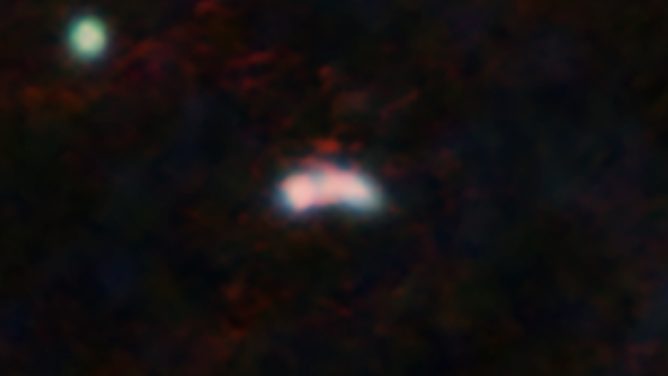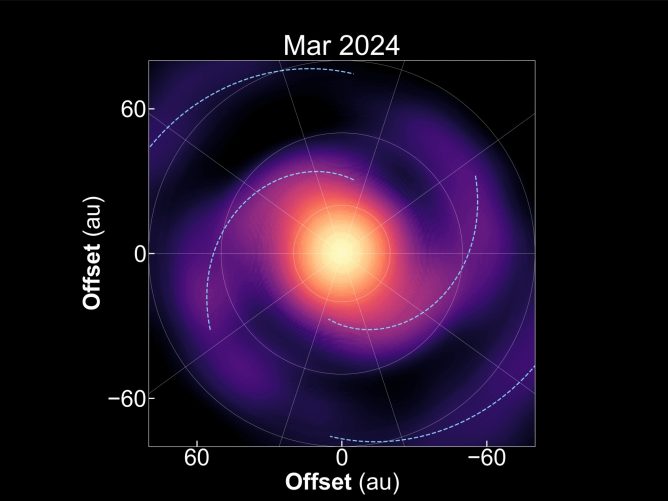2020.04.28
Universe Observed with Extreme Vision 【vol.4】Exploring Star Formation with Chemistry
Is the solar system similar to or different from other planetary systems in composition?
── I heard your research is to reveal the process of star formation using “chemistry” as a tool. Can you explain what do you mean by using “chemistry” as a tool?
Sakai: Well, what I want to know originally is whether the planetary system like ours is common or rare in the Universe. To find the answer, We are studying under what environment stars and planets are formed. In conventional research of this area, astronomers have been using “physics” as a tool.
── Using physics, not chemistry, as a tool?
Sakai: Right. A new star is formed by gravitational contraction of an interstellar molecular cloud.. In the course of this process, a rotating disk is formed around the protostar and is evolved into a planetary system. This theory is based on physics, looking at the movement of matter caused by gravity. In other words, it is studied by using physics as a tool.
── I see.
Sakai: Although this theory of star and planetary formation is quite understandable from a physical viewpoint, I had another question: “Are all of these stars and planets similar to our solar system or not?” Even if they are similar in shape or in size, they might be different in chemical composition. For example, there are chemical differences even within the solar system. The Earth’s atmosphere consists mostly of nitrogen (N2) and oxygen (O2), while the main component of Venusian atmosphere is carbon dioxide (CO2). These two planets are similar in size, but atmospheres are totally different. The Jupiter’s atmosphere is reductive (i.e. less abundant in oxygen and abundant in hydrogen) and is much different from both. Life exists only on the Earth as a result of chemical evolution during 46 billion years. And, the chemical composition in exoplanetary systems may have completely different chemical environment. So, if there was a star that has a planet very similar to the Earth somewhere, it wouldn’t necessarily have the same atmosphere or minerals as those of the Earth. Under different environmental conditions, different forms of life may be created, or no life could emerge. This is the reason why we need to look into chemical compositions as well.
Wine tasting tells us what happened to the wine in the past
── How can you confirm whether chemical compositions are similar or not?
Sakai: One of the ways is to use a radio telescope and detect radio waves emitted from molecules. Interstellar molecular cloud, where stars are formed, is composed of mostly hydrogen molecules, but contains a variety of other molecules in tiny quantities. These molecules have their specific radio emissions called “molecular emission lines”. By observing line emissions, we can find what kinds of molecules exist in star forming regions. I started my survey using the 45-m radio telescope in Nobeyama and observed various astronomical objects. I was surprised at the result showing seemingly similar newborn stars have distinctively different chemical compositions.

Radio emissions from carbon-chain molecule C4H around six newborn stars observed with the Nobeyama 45-m Telescope. While an intense emission was detected in IRAS 15398-3359, the C4H line is very faint in other objects. The results indicate that chemical compositions vary widely depending on the environment around newborn stars.
Credit: Sakai et al. 2009, ApJ 697, 769 [1] . Copyright: AAS. Reproduced with permission.
── What is revealed by the detection of different molecules or different chemical compositions?
Sakai: Physical factors, such as events that occurred before star formation and the length of star formation process, are all recorded as a history and emerge as differences in chemical compositions. I often explain this using an analogy of wine. Imagine, there are two bottles of wine made by the same chateau and in the same year. One is kept in a wine cellar, and another left under the scorching sun. After ten years, they may look apparently the same, but the taste must be totally different. We perceive the difference as soon as we taste it, and presume that this terrible wine must have been under the sun. Past physical conditions are engraved in the taste of wine, or in chemical compositions on a molecular level.
ALMA brings totally new vision in molecular observation!
── Is ALMA a powerful tool in studying the difference of chemical compositions in star forming regions?
Sakai: We could observe some simple and abundant molecules such as carbon monoxide (CO) even with conventional radio telescopes before ALMA. However, it was difficult to detect more complicated, rare molecules that emit only weak radio signals. Even if we could detect them, we wouldn’t be able to go further than obtaining their distribution map.
── How different will the results be with ALMA?
Sakai: Totally different. This is an image of a protostar in Taurus observed with an interferometer in France. It was an outstandingly competitive, high-performance telescope at that time, but only poor-quality images like this could be obtained in the observation of a line emission from a complicated molecule. We had a hard time putting the pieces together from these images in studying the gas kinematics.

Distribution of c-C3H2 molecule around the protostar L1527, observed with the Plateau de Bure Interferometer (PdBI) in France. The contour map in the lower left is the intensity distribution of emission from the molecule which shows there is an extended distribution surrounding the central protostar. The upper left and lower right images are maps of gas kinematics (position-velocity map) around the protostar based on the Doppler effect of radio emission from the molecule. In the position-velocity maps, as the contours extend all around, it is difficult to clarify the tendency of gas kinematics, including the velocity of gas in each region.
Credit: Sakai et al. 2010 ApJ, 722, 1633 [2] . Copyright: AAS. Reproduced with permission.
── Umm… I can’t understand these images at all.
Sakai: On the other hand, these are the images we obtained with ALMA just after it had started the early science observations with only 16 antennas. The target object is the same molecular line emission. Within a 30-minute observation, we could obtain the distribution of gas, as well as the gas kinematics in detail [3] .

The left image is the distribution of c-C3H2 molecule around the protostar L1527 observed with ALMA. The central area of the object, enlarged at seven-fold magnification compared with the image observed with the Plateau de Bure Interferometer (PdBI), reveals that the molecule extends in a disk form. The right image is the position-velocity map showing the relation between the moving speed and the position of c-C3H2 gas based on the Doppler effect. In comparison with the previous observation result, it becomes remarkably clear that the rotation speed gets slower as it goes further away from the protostar, and faster as it comes closer to the protostar.
Credit: N. Sakai /The University of Tokyo, All rights reserved.
── I can see a big improvement from the earlier one! What previously looked blurry has become much sharper. Did you expect such a high-quality image can be obtained with ALMA?
Sakai: I thought ALMA would give us the opportunity to study the distributions of various complicated molecules, but I didn’t expect to see the kinematics of molecules with such high resolution. When theory preceded observations, simulation studies suggested that there must be a disk around a protostar, but it had never been actually observed. Now, ALMA made it possible to clearly see a disk by the motions of complicated molecules that are chemically distinctive from others. I was thrilled to see that.
New Discovery from an Odd, Sooty Object
Sakai: Moreover, we found the target object has an unexpectedly unique chemical composition. It was an object contains a large amount of carbon-chain molecules like soot, but less amount of normal organic molecules like methanol.
── Were all objects supposed to be rich in organic molecules until then?
Sakai: Right. To be precise, the carbon-chain molecule is also a kind of organic molecule, but the organic molecule generally indicates methanol, alcohol or other stable molecules that are commonly found on the Earth. On the other hand, the carbon-chain molecule, which is a long chain of carbon atoms, easily react with other atoms or molecules to form other molecules. In outer space, however, the carbon-chain molecule is able to stay as it is because it rarely has contact with other atoms or molecules. After this odd, sooty object was found abundant in the L1527 star-forming core, we further examined the distribution of soot and discovered something unexpected. We found the “edge” of a disk made up of planet-forming gas and dust (i.e. protoplanetary disk).
── Was it the result published in 2014?
Sakai: Yes. Our original intention was not to find the edge of the disk, but to study how close the carbon-chain molecule remains in the surrounding gas around the protostar. Since the carbon-chain molecule is highly reactive, we assumed even if it could exist in the outer perimeter, it might disappear in the reaction with other atoms or molecules as the gas falls toward the center, leaving only organic molecules within the inner perimeter. As a result of the observation, it was found that the carbon-chain molecule disappears at a location much more inward than expected, which was the very edge of a forming protoplanetary disk. What we unexpectedly observed was the carbon-chain molecule which was accumulating on dust and disappearing at the edge of the disk.
──Hadn’t it been revealed where the edge of the disk would be?
Sakai: Previously we were studying the disk formation process using “physics” such as structures and kinematics as a tool, but it was difficult to separate the disk and surrounding gas. Now we have shifted our focus to the properties of molecules, which allows us to selectively observe a specific target, like observing only the surrounding gas around the disk, or only the edge of the disk where the collision of the surrounding gas is occurring. As a consequence, we could successfully identify the edge of the disk in combination with physical analysis of gas movement. Furthermore, our results provide an interesting insight. As carbon-chain molecules are absorbed by planet-forming dust particles, we assume that it could lead to chemical variations of planets depending on whether the disk is rich in carbon-chain molecules or normal organic molecules. We can explore further the origin of the diversity of planetary chemical compositions from this interesting discovery.
Molecular observation is similar to betting on horse racing!?
── You aimed at the carbon-chain molecule for your research on the disk structure. How do you determine what molecule you observe to achieve a specific scientific goal?
Sakai: It was totally incidental at the beginning. After I found an odd object rich in carbon-chain molecules in a star-forming region, I was curious to know how extensively this molecule could exist inside the disk. As a result of observations, we could unexpectedly see the edge of the disk due to the chemical signature of the molecule that disappears with the increased density of gas. In the observation, we tentatively set the telescope so that we can simultaneously observe both SO (sulfur monoxide) emission line and the carbon-chain molecule, making use of the best capabilities of ALMA, and this tentative setting led to a new discovery. You might say it was an unexpected good luck, but it also might be an intended outcome because we made an observation of two different types of molecules on purpose.
── If you observe a larger number of molecules, you have more chance of new discoveries.
Sakai: Right. Since each molecule has distinctive chemical features, we would like to observe different types of molecules at the same time if possible. Even if we couldn’t detect the target molecule, it would be new useful input because non-existence of the molecule indicates something. In our observation proposal, we provide the purpose of observation, specifying what will be found by observing the target molecule. However, we also have the intention to obtain additional data of other molecules beyond what is planned as far as possible.
── Do you have a feeling as if you hit the jackpot when you made a big discovery from the molecule you tentatively observed?
Sakai: Exactly. I would say it’s similar to horse racing. Imagine a fancied horse whose victory is expected by everyone. We surely bet on the horse, but the race would be more exciting when it takes an unexpected turn with a dark horse. Assuming such a possibility, we must also keep our eye on other promising horses that would have a chance to win. In the same way, we have a “main target” which is planned in our observation proposal. While we try to never miss the most desired target that has more chance to bring expected results, we might be sometimes blessed with a surprise when the plan turns out differently or something unexpected happens. I don’t want to miss such a “dark horse”, so I try to include other molecules that can be observed simultaneously with the main target as far as practicable. Other astronomers may have a different stance or approach, but I like seeking dark horses.
── I guess you are quite a gambler! Do you actually bet on horse racing?
Sakai: Not so often, these days (laugh).
Is our solar system common among planetary systems?
── Could you explain your research plan for the future?
Sakai: I mentioned this at the beginning, but once again my goal is to reveal whether our solar system is common or not among other planetary systems. What I need to do now is to survey more extensively chemical compositions in various star forming regions to identify the mainstream of planetary systems. At this point, it is yet to be confirmed what is the mainstream; it might be a sooty object or organic-molecule-dominant object, or something completely different in chemical composition. We still have a lot to investigate.
── Don’t you even know whether the solar system is soot-dominant or organic-molecule-dominant at this point?
Sakai: We have no clue about it.
── Is it possible to discover the third or fourth system with totally different chemical compositions?
Sakai: We are in the midst of the search right now. We couldn’t see what molecules are contained in a disk-size region until the completion of ALMA, so this is what we are addressing now. As ALMA started the full-fledged operations and other various large-scale-observation projects are underway, there will be more scientific results from now on.
── You are working on the study to find out whether the solar system is common or rare in the Universe. Is it possible to explore further and reveal whether Earth-like planets are common or rare in the future?
Sakai: There are various physical conditions necessary to form Earth-like planets. For example, temperature needs to be in a range that allows the existence of liquid water. What I’d like to mention here is that chemical factors should also be considered in discussions on this subject. As you know, a small simple molecule grows into a larger complex molecule, and the aggregation of large complex molecules finally evolves into life. Chemical composition is a key factor for a deeper understanding. So, my dream is to devote myself to the study in the relevant field.
── Do you still have a long way to go?
Sakai: We’ve just come to be able to resolve a planet-forming region to see the distributions of various molecules. However, as a planetary system has a size equivalent to 100 au (approximately 100 times the mean distance between the Earth and the Sun), it’s like we are seeing a panoramic view of the entire solar system, not looking at each planet one by one. This is the point where we astronomers feel the gap in discussions with planetary scientists. We haven’t yet studied a variety of molecules resolved into the size of the earth orbit. Also, we obtained the comprehensive view of the forming planetary system, but not yet the view of the target molecules on each forming planet individually.
── Is it difficult to see the forming process of each planet with ALMA?
Sakai: Probably, it would not be easy with the present capability of ALMA, although it might be possible if it targets a limited number of young stars in the vicinity of the Sun. As ALMA has a plan to improve its resolution, further technical advancement would be needed to see the formation process of individual planets. I dream of reaching that goal. Having said that, I’m also afraid that my work would be more complicated if such observation has been carried out before clarifying the chemical diversity of planet forming disks. So, I will start from clarifying how wide the variation of protoplanetary disks is. While studying variations in shape and in chemical compositions, I explore where such variations come from and figure out what the percentage of each category of planets is.
| 1 | N. Sakai et al. “Discovery of the Second Warm Carbon-Chain-Chemistry Source, IRAS15398−3359 in LUPUS”, The Astrophysical Journal, Vol. 697, Number 1, published in May 2009. |
|---|---|
| 2 | N. Sakai et al. “Distributions of Carbon-Chain Molecules in L1527”, The Astrophysical Journal, Vol. 722, pp.1633-1643, published in October 2010. |
| 3 | N. Sakai et al. “Change in the chemical composition of infalling gas forming a disk around a protostar”, Nature, Vol. 507, pp. 78-80, published in March 2014 |










